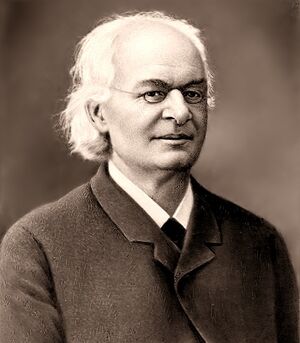Hermann Trautschold facts for kids
Quick facts for kids
Hermann Trautschold
|
|
|---|---|

Gustav Heinrich Ludwig Hermann Trautschold
|
|
| Born | 17 September 1817 |
| Died | 22 October 1902 (aged 85) |
| Resting place | Heidelberg |
| Nationality | German |
| Other names | Russian: Ге́рман Адо́льфович Траутшо́льд |
| Citizenship | German Empire, Russian Empire |
| Alma mater | University of Giessen |
| Scientific career | |
| Fields | geology and paleontology |
| Institutions | University of Giessen Petrovsky Agricultural and Forestry Academy |
| Doctoral advisor | Justus von Liebig |
| Notes | |
|
His brother Wilhelm Trautschold was a painter.
|
|
Hermann Trautschold (born September 17, 1817 – died October 22, 1902) was a German-Russian scientist. He was a geologist, which means he studied Earth's rocks and history. He was also a paleontologist, someone who studies ancient life through fossils. Besides that, he was a pharmacist, a person who prepares and dispenses medicines. From 1869 to 1888, he taught at the Petrovsky Agricultural and Forestry Academy. Trautschold was especially known for his work on ancient rock layers and fossils in the European part of Russia. He focused on rocks from the Carboniferous, Jurassic, and Cretaceous periods. His brother, Wilhelm Trautschold, was a painter.
Contents
Early Life and Education
Hermann Gustav Heinrich Ludwig Trautschold was born in Berlin on September 17, 1817. His father, Adolf Christoph Ludwig Trautschold, was a merchant. Hermann went to primary school in Spandau and then to a grammar school in Berlin.
In 1844, Trautschold traveled to Spain to study plants. After that, he went to the University of Giessen. There, he deeply studied chemistry, mineralogy (the study of minerals), and crystallography (the study of crystals). He was most interested in geology and paleontology. While studying, he worked for about a year and a half with a famous chemist named Justus von Liebig. In 1847, he finished his studies and earned a doctorate degree from the University of Giessen.
A Life of Discovery
From 1847 to 1849, Trautschold traveled through Italy, Germany, and Russia. During these trips, he carried out important geological research. While in Russia, he worked as a private tutor for a family in Moscow. He had met the family's landowner, F.N. Luginin, in Germany. One of Trautschold's students, Vladimir, later became a well-known physicist. In Russia, people knew Hermann Trautschold as Gérman Adólʹfovich. In 1848, he went back to Germany. From 1849 to 1857, he was the head of a private school there.
In 1863, Trautschold was invited to teach German at Moscow University. He taught physics, mathematics, and medicine students. He also worked on translating science books. Through this work, he became very good at the Russian language. However, he could only do his favorite work, geological research, in his free time.
Exploring Earth's Past
When he worked at the Petrovsky Academy, Trautschold spent a lot of time studying ancient rock layers. He focused on rocks from the Carboniferous and Jurassic periods in the Moscow region. He also took many long trips to explore the geology of the Volga, Ural, Donbas, Crimea, and Northern Caucasus areas.
Trautschold was not just a lecturer. He also organized geological trips for his students. He worked hard to add to the Petrovsky Academy's collection of minerals, which he was in charge of. Some of his rock and fossil collections went to Strasbourg and Lisbon, but they are no longer there. In Russia, much of his collection is now at the State Vernadsky Museum of Geology in Moscow.
He believed in Charles Darwin's theory of evolution. This theory explains how living things change over time. Trautschold used his fossil discoveries and his teaching to support this idea. He also helped promote the work of another paleontologist, Vladimir Kovalevsky, in Russia. Trautschold also helped people in Russia learn more about the famous explorer and scientist Alexander von Humboldt.
Because there were not many geology textbooks in Russian, he wrote his own. It was called "Fundamentals of Geology" and had three parts: "Geography and Geomorphy," "Paleontology," and "Stratigraphy."
From 1872 to 1886, he was the secretary of the Moscow Society of Naturalists. In 1884, he became a member of the German National Academy of Sciences Leopoldina. He was also an honorary member of the Silesian Society for Patriotic Culture and the German Geological Society. He was also an honorary member of the Belgian Geological Society.
Death
Hermann Trautschold died in Karlsruhe on October 22, 1902.
Honoring a Scientist
Many ancient creatures have been named in honor of G. A. Trautshold. These names help us remember his important work.
- Two types of ammonites (ancient sea creatures with spiral shells) were named after him: Acanthohoplites trautscholdi and Alphachoristites trautscholdi.
- A type of brachiopod (a marine animal with two shells) from the Jurassic period was named Zeilleria trautscholdi.
- An ichthyosaur (an ancient marine reptile) from the Jurassic period was named Undorosaurus trautscholdi.
- A type of synapsid (an ancient reptile-like animal) from the Permian period was named Vivaxosaurus trautscholdi.
- Two types of horn corals (ancient sea animals) from the Carboniferous period were named Lophophyllum trautscholdi and Stereophrentis trautscholdi.
- A genus (a group) of sea lilies (ancient marine animals that look like plants) was named Trautscholdicrinus.
Works
- Hermann Trautschold Übergänge und Zwischenvarietäten Universitäts-Buchdruck 1861
- Hermann Trautschold Ueber säkulare Hebungen und Senkungen der Erdoberfläche Habilitations-Abhandlung Kaiserlich Universität 1869

